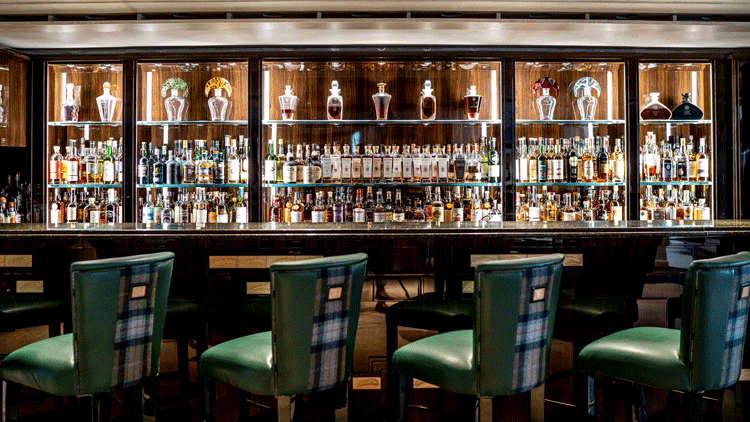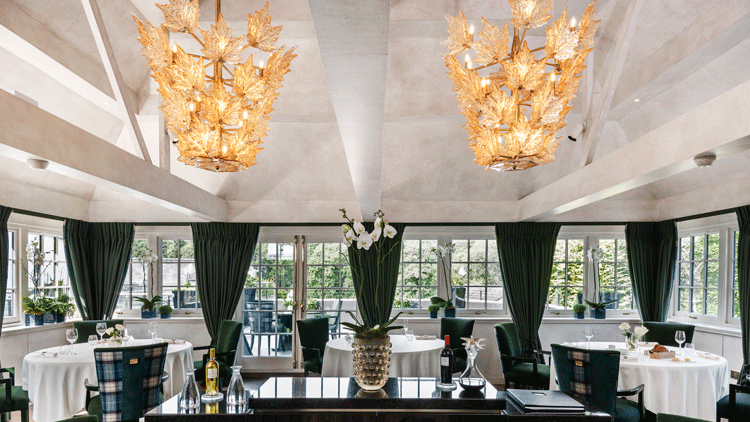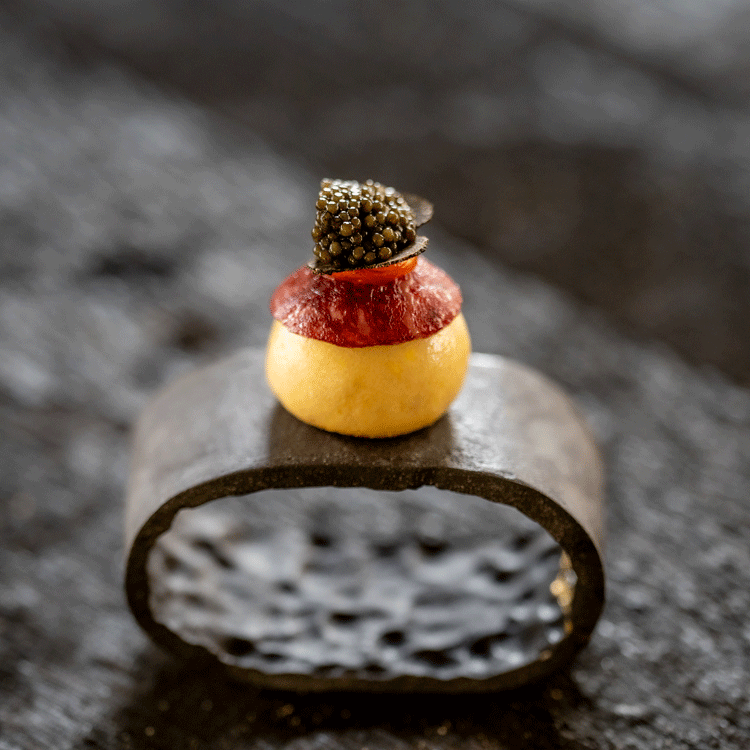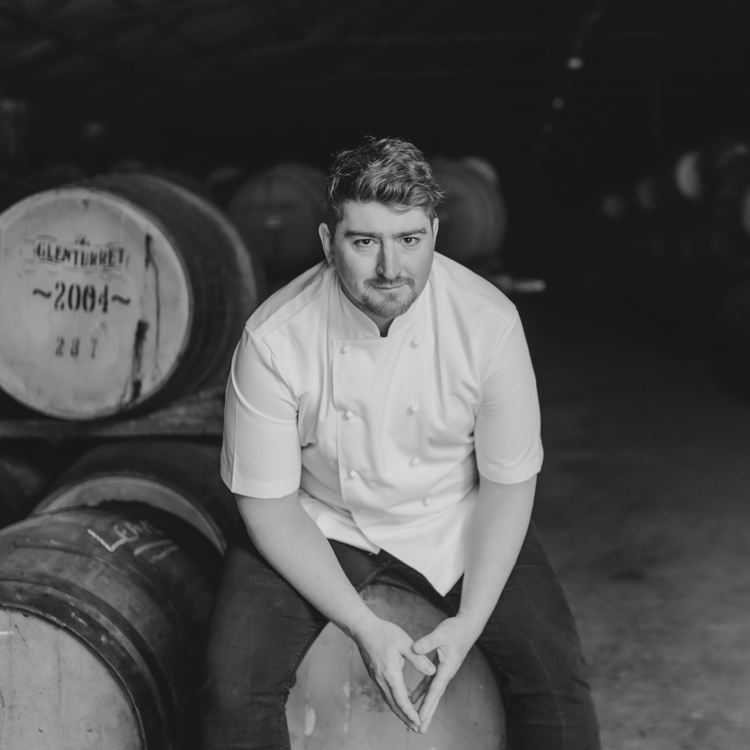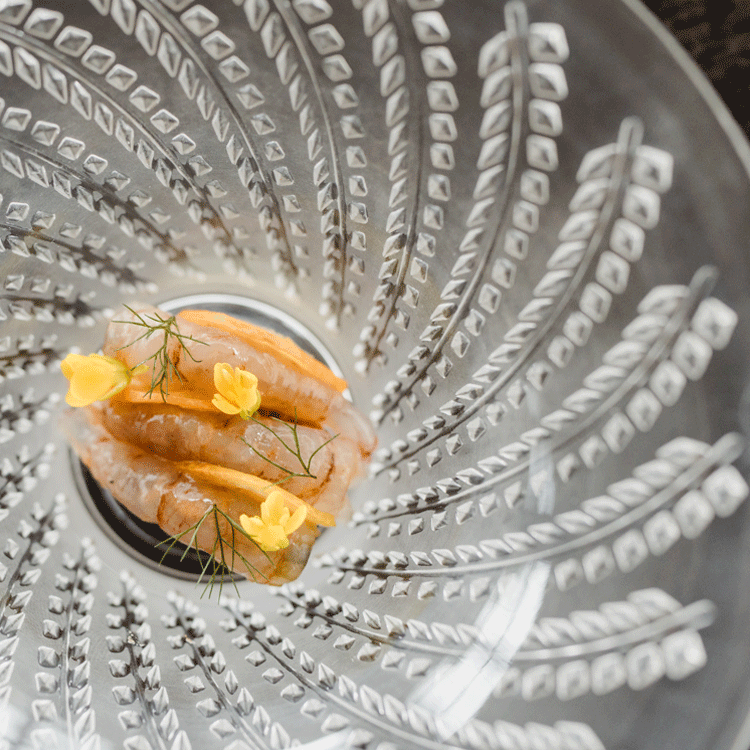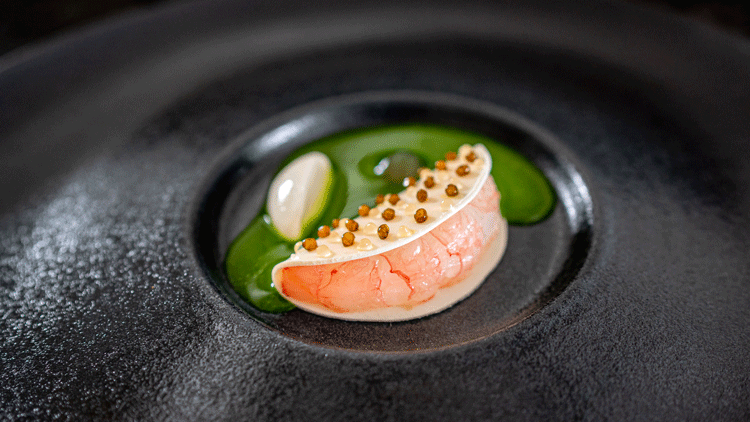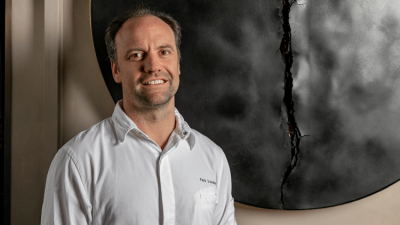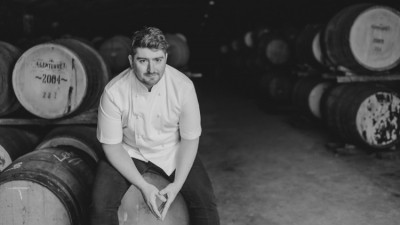Meet the new face of progressive Scottish cuisine

The chauffeur that drives us the hour or so from Glasgow Airport to The Glenturret Lalique describes its chef patron as an “unmade bed”.
Upon meeting Mark Donald this seems a little uncharitable, but he does largely defy the stereotype of the clean cut, anal retentive multi-Michelin star chef in both appearance and attitude. “I am meticulous with certain things in the kitchen, but I am a little rough around the edges. I'm a six-foot-two Scottish ginger guy. That needs to come through in my food,” says Donald who, by his own admission, bears more than a passing resemblance to the Swedish chef from the muppets.
Self-depreciating to a fault, the Glasgow-born chef is regularly hilarious in his dour delivery. When I ask him what will change at his whisky distillery-based restaurant following its promotion from one to two stars earlier this year he pauses thoughtfully before reeling off a list of increasingly unlikely projects including a sponsorship deal with a high-end chef clothing brand, a line of non-stick pans for the retailer Home Bargains and a new burger chain called – inevitably - Mark Donald’s.
The truth is that little will change at The Glenturret Lalique, which is located near Crieff at the foot of the Highlands just a short drive from Gleneagles, the home of Scotland’s other two-star (and Donald’s former employer) Restaurant Andrew Fairlie.
"I'm a six-foot-two Scottish ginger guy. That needs to come through in my food"
“The menu price, the food and the service will remain the same. We got to this point quickly, but it was organic,” says Donald, whose cooking CV also includes Claude Bosi’s Hibiscus, and Noma. “It would be a huge misstep to start doing certain things now just because we have two stars. I might look at some new crockery, though.”
But The Glenturret Lalique’s two-star plaque has given Donald – who is endearingly unsure of himself despite his obvious culinary abilities - a much needed confidence boost. “I'm a hugely self-critical person. I was raised by three Scottish women (his mother and his two older sisters). I can’t walk past a mirror without thinking I’m fat. I’m so hard on myself that it is to my own detriment at times. But I don’t settle on something until it’s exactly right, which is a good quality for a chef.”
One of Scotland’s oldest distilleries
The success of Donald’s restaurant – it is also rated as the best in Scotland on Restaurant’s own list of the top 100 restaurants in the UK - has echoed that of the distillery itself. The Glenturret was previously the home of The Famous Grouse brand, producing much of the single malt for one of the UK’s bestselling blended Scotch whiskies. But that all changed in 2019 when the tiny distillery was sold to the French-owned Lalique Group and Swiss entrepreneur Hansjörg Wyss (both hold a 50% stake).
Following the sale, The Glenturret has sought to transform itself into a luxury brand with the launch of a high-reaching restaurant and a whisky that is marketed under its own name in bottles designed by Lalique, which is famous for its ornate crystalware. In its new guise, The Glenturret has leant heavily on its status as one of Scotland’s oldest working distilleries (records go back to 1763, which the distillery says makes it the oldest, although this is contested). The Glenturret’s new expressions have been well-received, with its 2022 Triple Wood release named the world’s top single malt at the 2023 International Wines and Spirits Competition.
Avoiding ‘Malt Disney’
There are a little under 150 whisky distilleries in Scotland, the majority of which are open to the public, but only a handful incorporate a restaurant of any ambition. Indeed, the majority don’t have much truck with food at all.
“It’s not easy to run a good restaurant in a distillery. It’s not like a vineyard. Whisky is not the same as wine. We can’t offer a tasting menu in which the majority of courses are paired with whisky. You can serve five or six glasses of wine without risking your guests starting a fight or trying to drive their taxi driver home.”
Another major concern for Donald – and one that nearly stopped him taking the job of launching The Glenturret Lalique when it was offered to him at the tail end of the pandemic – was that his dream of running a serious gastronomic restaurant would dissolve into a tartan-tat nightmare of sporrans, shortbread and Scottie dogs.
“Initially I thought ‘haggis bonbons and whisky sauce? No thanks’. But then I came to see the distillery, smelt the whisky being made and fell in love with it a wee bit. Plus, you could pick mushrooms out the back.”
"You can serve five or six glasses of wine without risking your guests starting a fight or trying to drive their taxi driver home"
Donald’s principal challenge at The Glenturret is to appease whisky fans that have come for a dining experience centred on the spirit while staying creative and avoiding a themed feel. “We’re not doing Malt Disney here. I want to smash people’s expectations of what a restaurant in a distillery should be like.”
His solution is to create a sense of time and place by focusing on the whisky-making process - nods of which are woven through the meal but aren’t necessarily mentioned by staff or flagged on The Glenturret Lalique’s £195 tasting menu - rather than the final product while also bringing the terroir that surrounds the distillery into the conversation.
Malted barley-based misos, shoyus and garums underpin the flavour of much of Donald’s food, peat is used on the barbecue in preference of smoking chips, and whisky is used in place of brandy in some of the kitchen’s sauces. Donald’s bread course is a sourdough made with draff, AKA spent barley, that’s brushed with a butter and beer emulsion (in whisky making, the typically 6-8% abv liquid that goes into the pot still to become a spirit is essentially a beer).
“We have spent a lot of time with the distillery team getting to understand the whisky making process. I’m particularly interested in the conversion of complex carbohydrates into sugars through the fermentation of the malted barley and the flavours that creates,” says Donald, who is spending more and more time with The Glenturret’s master blender Bob Dalgarno tasting and discussing the finer points of whisky and food matching (the pair both have great palates, but their lexicon for describing flavours is notably different).
Catering to people that don’t like whisky
With an aesthetic that was finalised before Donald arrived (he took over from a French chef that “bottled it”) The Glenturret Lalique’s 28-cover dining room was designed by a company that specialises in luxury yachts. Its centrepiece are two large Lalique crystal chandelier with much of the tableware – and all the glasses – also supplied by Lalique. Though tastefully done, it is verging on the traditional and therefore a little out of step with Donald’s progressive cuisine. The £115 drinks pairing eschews whisky – the intention is for people to finish with one in the bar – and is eclectic, juxtaposing classics with more leftfield choices including a sake and a wine from cult northeast Italian low intervention producer Radikon.
As odd as it sounds given the distillery setting, Donald is aware that whisky is a polarising drink: not all of diners will be fans. In recognition of this, whisky is only used as an ingredient in a couple of the 15 or so items that hit the table over the course of the meal, most memorably in a caramel sauce that accompanies a chocolate and green coffee mille-feuille.
A menu dictated by quality rather than provenance
Donald might be looking to create a sense of place with his food, but that does not mean a Noma-esque sourcing policy that precludes ingredients from further afield. “I’m not going to sit here and say everything is from down the road, because it isn’t. The menu here is dictated by quality rather than provenance.”
Happily, a lot of the produce on the kitchen’s doorstep is world class. Girolles and ceps grow in the forest that surrounds the distillery, roe deer and pheasants roam in Donald’s garden and his beef comes from Highland Wagyu, which is just down the road. “I wouldn’t get shellfish or game from anywhere other than Scotland either. I’m lucky that a lot of the stuff round here is good. But you can’t grow lemons in Scotland. There are times of the year you can’t even grow turnips.”
From rags to riches – Donald’s tattie scone
As important as whisky is to the Glenturret experience, Donald also wants his own culinary make up to be part of the conversation. To this end, the menu explores the often-unsung dishes and ingredients he has grown up with, including spoots - the Scottish word for razor clams that literally means spout because of their habit of squirting water in the face of those trying to prepare them – and the tattie scone.
The latter is the inspiration behind what has become his most famous dish. By some margin the most complex thing on his menu requiring its own dedicated section, his one-bite take on the working-class staple is essentially a very tasty joke.
"A tattie scone is one of the cheapest things you can make. It's born out of necessity. It’s potatoes combined with flour to make them go further and to last longer. I love them. We have turned that idea on its head by creating something that is very luxurious.”
Donald’s take is a potato bao filled with a potato and chicken fat mayonnaise that’s topped with egg yolk jam, a reduction of beef sauce, a sheet of raw wagyu, black truffle and Osteria caviar. The genius of the dish is that it really is redolent of having a tattie scone with its traditional accompaniment of fried bacon and eggs.
Other dishes that demonstrate Donald’s playful side include a lobster ‘bisque-it’ shaped to resemble the crustacean that encases a set bisque; and the ‘foievioli’, another single-bite dish that combines ethereally-light pasta wrapped around foie gras filling topped with a disc of black truffle.
In contrast to Donald’s smaller items, his more substantial dishes – including barbecued red mullet with black trompette and Crown Prince pumpkin; and juniper-smoked roe deer served with little more than a perfectly executed sauce - tend to let the produce do the talking. “In some dishes things just get lost. I want people to notice the cuisson on my fish and the quality of the venison. If you have too many elements on the plate, they probably won’t.”
Rough around the edges
Born and raised just outside Glasgow in a little farming village called Torrance, Donald did well at school and was artistically inclined. “The creativity was always there but I was not necessarily accepted by my mentors. Again, it was a case of me being rough around the edges. It didn’t help that I was the last Donald child to go through school. I didn’t compare well to my two older sisters, who were very talented artists,” he says.
He was accepted at all the universities he applied for and also secured an audition for Glasgow’s prestigious Royal Conservatoire of Scotland. But he never turned up for it. “I didn’t bottle it exactly. I was working in a basic pub washing dishes and got completely sucked into it. Even at that low level there was something addictive about it. I used to come into the kitchen on my days off.”
After a gap year in Australia, he spent four years at Glasgow’s Stravaigin, which was one of the highest rated restaurants in the city at the time. This led to a stage with Andrew Fairlie at Gleneagles. Donald made the cut, but there were no positions available so he headed to Noma for what would become a five-month placement during which time the restaurant went from number three in the world to number one (in 2010). “It was a cool time to be there,” says Donald in his typically understated manner.
"There were some people in the kitchen at Noma that could pull sea buckthorn leather out of their arse but could not roast a chicken"
Noma chef patron René Redzepi offered Donald a senior role in his brigade, but a position had also come up with Andrew Fairlie, meaning there was a choice to be made between Noma’s free-form creative approach and something more classic and militant.
“It was a difficult decision because René was a potential springboard, there were people that had gone stratospheric after working with him for a few years. But there were some people in the kitchen at Noma that could pull sea buckthorn leather out of their arse but could not roast a chicken. I wanted to continue to learn how to cook so I went with Andrew. I don’t regret it.”
A lesson in discipline
Busted back down to commis chef - at the time, everyone started on the kitchen’s lowliest rung irrespective of their previous experience - Donald spent three years working under Fairlie in a tough, regimented but ultimately nurturing environment. “It wasn’t a shouty kitchen, but it was very specific. I could cook, but I was undisciplined. People commented on the way I stood and how I folded my tea towels. It was a little overbearing, but it was good for me.”
While at Gleneagles Donald struck up a ‘bromance’ with Ian Scaramuzza and ended up following him to Claude Bosi’s Hibiscus restaurant in Mayfair. “I’d vowed never to work in London because of its reputation for horrible kitchens, Hibiscus being at the very pinnacle of that,” Donald laughs. “But Ian needed a sous chef, so obviously I went.”
The kitchen at Bosi’s (now closed) Maddox Street restaurant was notoriously tough with a reputation for making or breaking people. Happily, Donald was part of the former camp. “There was a revolving door. Claude is a really gifted chef. Working there did so much for my touch and taste. You become very intuitive because you have to be. You can’t fuck it up. I don’t regret a minute of it. Ian and I thrived. But it wasn’t for everyone. I’ve heard he’s softened up a bit recently so hopefully he won’t kick my arse when he reads this,” says Donald, who clearly has great admiration for his “big, angry and very French” former boss.
A spell down under
While at Hibiscus Donald met his now wife Maddie and travelled back to Australia with her as her visa ran out. He had been down to help open a restaurant for Loh Lik Peng with another Noma alumnus but the project fell through causing headaches with his own work visa. He took a job at Brent Savage’s influential Bentley restaurant in Sydney and just a few months later found himself running the place.
In 2018 he and Maddie returned to the UK. “I missed home. The weather in Australia was too nice. It didn’t feel like real life,” says Donald who having initially struggled to secure a role in a top kitchen befitting of what was now an impressive CV eventually took over the kitchen at Number One at The Balmoral, one of Scotland’s best known fine dining restaurants.
“Taking over a stalwart of Scottish gastronomy was daunting. In fact, a big part of me didn’t want to do it because I knew I would have to change everything,” says Donald, who despite significant pushback from certain quarters made sweeping and ultimately successful changes. While it doesn’t sound like he had much fun doing it, Donald retained the Edinburgh restaurant’s Michelin star for two years in a row.
Following Covid, Donald and team came out swinging with new ideas but his time at the hotel was cut short by the offer of a largely blank canvas at the distillery. He ended up doing an ‘Aubergine’ by taking nearly all of his kitchen and front of house team to his new place with him, including Alex Angelogiannis, the current holder of the National Chef of the Year title, and Kayleigh Turner, who recently won Pastry Chef of the Year at the Scottish Food & Drink Awards.
Free-rein in the kitchen
One of the central appeals of The Glenturret project is that Donald has about as much free rein in the kitchen that a chef working for somebody else could reasonably expect. The only hitch is that he is required to manage the whole of The Glenturret’s F&B (Maddie oversees the tours and events). In this sense, the distillery is a bit like a hotel, only without the rooms.
This includes a high-end but more casual and eclectic lunchtime menu that’s served within the bar that’s adjacent to the main dining room and a basic canteen that’s mainly frequented by locals and distillery workers. While the latter does sit uneasily alongside Glenturret’s wider offering – which includes a Lalique giftshop that sells furiously expensive glassware, objet d’art and jewellery – one does get the sense that a bit of Donald quite likes selling Mars bars, cans of Irn Bru and bowls of homemade Scotch broth so thick that the spoon stands up.
“I busted my ass and bled for people in two-star restaurants and maintained their ridiculous standards in a much harder environment than I have created here"
Donald might not be a typical two-star chef, but he certainly is a product of the upper end of the restaurant industry. Though he wears the physical and emotional scars that come with working at the very top with a certain amount of pride, he is also conflicted. It seems that he has come to the realisation that – having now attracted two stars himself – it might be possible to work at a very high level without being a tyrant.
“I busted my ass and bled for people in two-star restaurants and maintained their ridiculous standards in a much harder environment than I have created here,” he says.
Donald wasn’t surprised when The Glenturret Lalique won its first star in the 2022 Michelin Guide, but two stars coming so soon after was unexpected.
“It was a huge personal and professional goal for me. A big part of me thought it would never happen. But now that we have two stars it’s going to be different.
"It’s much easier running a one-star restaurant that is pushing for two stars than a two-star restaurant. People will be looking for faults. But the biggest pressure will be the one that I place on my own shoulders."

